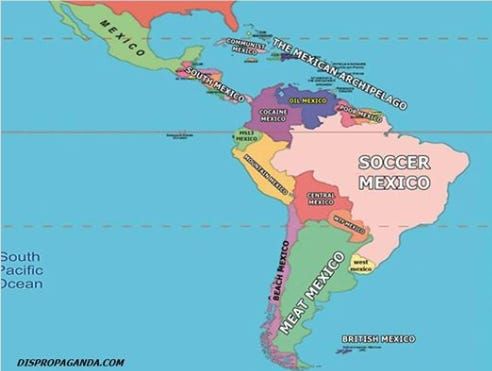Parsing risk and making deadline
A freelance foreign correspondent field note

Dear friends,
There’s a funny trick that news media and advocacy organisations like to pull every now and then, where someone will write a report on a developed country in the same manner as ‘developing’ nations tend to be in the global MSM. So you’ll get Missouri described as “a restive American province”, with Ferguson “a remote …village that has been a hotbed of sectarian tension”.
Like the famous ‘Body ritual among the Nacirema’ article used to teach new students of anthropology, these tricks make for good learning about cultural comparison and geopolitics. Missouri and the Nacirema are rendered otherly by cultural and political power, in a demonstration of how news narratives of foreign places tend to reinforce inequality and dominance by diminutising ‘third world’ or ‘developing’ spaces as eternally conflict-ridden, curious, and somewhat inconsequential to the real business of international relations. (In another piece, a British foreign correspondent in Johannesburg who covers Southern Africa uses the trick to talk about Brexit, in a tone that belies the fear and stigma of ‘becoming third world’, an affect which regularly features in political commentary around the world).

Image: ‘Two Undiscovered Amerindians visit Madrid’, from ‘The Couple in the Cage’ by Coco Fusco and Guillermo Gómez-Peña
The displaced
This week I had the task of reporting on two events of displacement from the mountains of the state of Guerrero here in Mexico, and the fight of the people so displaced to return safely to their pueblos (=villages/small towns).
Guerrero is the kind of place that gets referred to as a Troubled Region (it’s in one of the Mexicos, after all). I’ve been reporting on/from there since August last year.;I’m getting invested.
The ‘desplazados’ (displaced people) fled their homes in November when armed groups associated with organized crime (drug cartels, the ‘narco’) invaded, looting houses and killing residents*. They ended up sheltering in an old auditorium in one neighbouring town and a covered basketball court in another.
Recently, the desplazados took their fight to Mexico City - camping out in front of the National Palace of government in the Zócalo (central plaza) until they were able to secure an agreement with the federal government who has promised to provide additional security and humanitarian aid over the coming months so that the displaced can return to their pueblos in peace.
The global reader
I had to re-submit the story three times before the editor and I could come up with a piece that describes the situation in terms general and succinct enough for ‘the global reader’, our intended audience - i.e. people who are interested in what’s happening around the world but have no prior knowledge of the situation being reported on.
Balancing compelling words with The Facts is always a challenge for Doing Journalism, but the challenge was particularly sharp in this case.
First of all, I was close to the complexity and long, live history of the kind of conflict that the displaced in the story are running from. Since beginning to report on Guerrero in August last year, I’ve only learned more detail every day. It’s one of those situations where the moment you think you’ve understood it, you learn something else that demonstrates you still have no idea.
At the same time, I was not so close to the story to not feel extremely anxiously and ambivalently placed in relation to the testimonies I was hearing from the displaced - stories of horrible violence and terrible personal loss that I have a responsibility to report accurately, in translation from Spanish, that I am hearing as a result of recent and hard-won relationship building, and whose verification is very difficult if not impossible to guarantee due to the climate of fear and violence (e.g., I can’t trek into the mountains to check which armed gang might have been behind one specific conflict, invasion, or shooting, because it is too dangerous).
Relatedly, beyond the essentials of consent, the opacity of the situation and my relative newness to the scene makes it difficult to parse the risk to my ‘subjects’ of further violence if they appear in a foreign media story - and indeed to parse the risk to myself as a foreign journalist reporting on such fraught matters.
So. I was asking the story to manage all of those tensions while my (excellent) editor needed it to be .. you know, actually interesting and readable to the curious, relatively uninformed, reader, who was likely to be putting their eyes on the story from the other side of the continent.
We finally got there - I think the story is now one that’s both factual and readable, although the whole process made me wonder if it is actually possible to write foreign correspondence that resists the cliches and biases of ‘the developed world’.
I’ll share the piece when it’s published next week, and would love to hear from you, dear ‘global reader’, about it. (<= This kind of reflection is also to help in the ongoing collective project of figuring out the worth of this whole caper. Item: I’ll be paid 400USD for the piece, which obviously took many days to report and write).
Next time, I’ll share some stories from sharing my reporting with the people being reported on. And there’ll be a special guest interview, involving samba! (YA GIRL IS FUN OK!).
Thanks so much for reading, I hope you all have a wonderful week,
Ann.

Image: the Mexicos. (seen on fb).
*if you’re interested in learning more about Guerrero’s hardships, Desert Sun in the US recently published this very readable and informative series of articles.